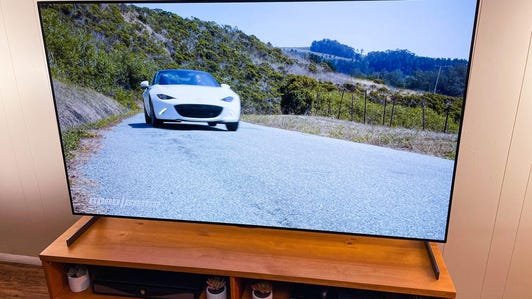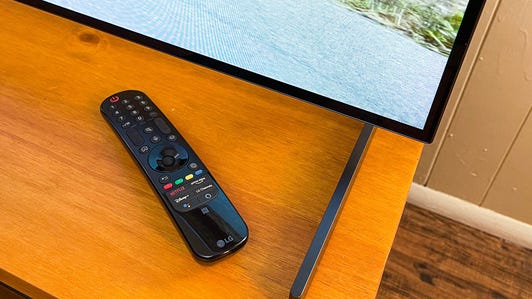
For years OLED TVs have delivered the best image quality available with display technology that has remained largely unchanged, but LG promised something even better for 2021. The G1 has an all-new panel not available on any other TV LG sells. The company calls it Evo and says it achieves higher brightness and improved color. My verdict? Yes, it's slightly better than before but even in a side-by-side comparison, it was difficult to tell the difference.
Like
- Best picture quality we've ever tested
- Slightly brighter than previous models
- Beautiful slim design perfect for wall-mounting
Don't Like
- Expensive
- Image quality improvements over cheaper OLED TVs are minor
I set up the G1 next to the CX, the best TV I reviewed in 2020, measured both and watched a variety of TV shows, movies and games. The G1 was indeed a bit brighter than the CX but color was nearly identical, as were other aspects of picture quality like video processing and uniformity. Both looked spectacular, however, and in most material I really couldn't say one looked better than the other.
The main advantage the G1 has over the CX and pretty much every other OLED TV is its unique design. This TV is made to be wall-mounted -- quite literally; it doesn't even come with a stand! If you want to put it on a piece of furniture, as shown in the images in this review, you'll have to pay $100 extra for LG's little side legs. And that would be a shame, because something this thin should really be on a wall.
New for 2021 LG has improved its already best-in-class gaming features by adding picture modes especially for games, as well as a convenient menu that shows all gaming info and adjustments in one place. There's a new remote and a new smart TV homepage, too. The more affordable C1 shares those features with the G1, however.
At this point, the G1 is the best TV I've ever tested -- by a nose. I have yet to review its competitor from Sony, the A90J, which also promises a brighter panel, or any other high-end TVs like Samsung's Neo QLED models, so that title might not last. But for people who don't have money to burn, the extra picture quality of the G1 probably isn't worth the extra money over mainstream OLED models like the CX or C1.
Get to know the LG G1 series
- It comes in three sizes and costs a bundle: 55-inch ($2,200), 65-inch ($3,000) and 77-inch ($4,500).
- It differs from the less expensive C1 series by offering fewer sizes (the C1 has 48-inch and 82-inch options too), that Evo panel and the slimmer, wall-mount-centric Gallery design. The C1 also lacks a far-field mic for hands-free voice and a Next-Gen TV tuner, both relatively minor extras included on the G1.
- OLED display technology is fundamentally different from the LED LCD technology used in the vast majority of today's TVs, including Samsung and TCL's QLED models.
- The best LCD TVs I've reviewed so far scored a 9 in image quality, while OLEDs TVs like the G1 have scored a 10. High-end LCDs (especially with HDR) are brighter than OLEDs, but the picture quality on OLED TVs, including that of this G1, is superior overall.
- All OLED TVs are more subject to both temporary and permanent image retention, aka burn-in, than LCD TVs. We at CNET don't consider burn-in a reason for most people to avoid buying an OLED TV, however. Check out our guide to OLED burn-in for more.
Throw it at the wall
A TV doesn't get any more minimalist than this. Like many sets these days the G1 is pretty much all picture when seen from the front, but it's the side view that sets it apart. It measures just 0.8 inches deep and is designed for nearly flush wall-mounting. And as I mentioned at the top, it doesn't even come with a tabletop stand: If you want a stand mount, it will cost $100 extra.
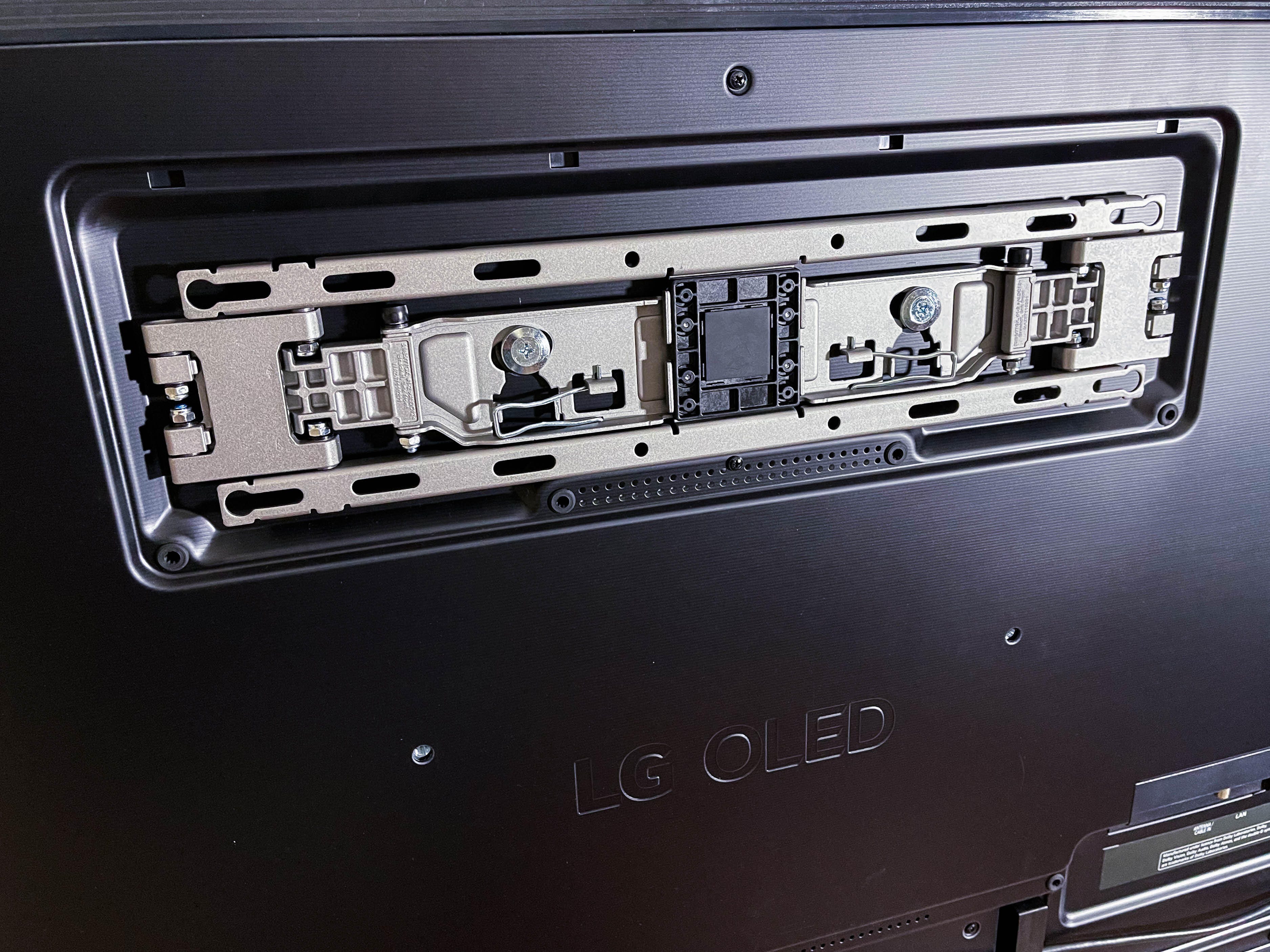
The G1 comes with a wall-mount bracket inset into a cavity on the back for a practically flush mount.
Sarah Tew/CNET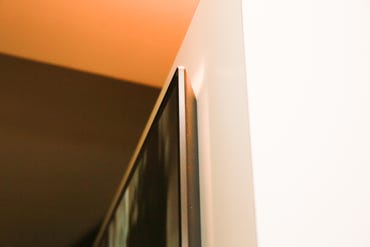
Here's what it looks like flush against the wall.
Sarah Tew/CNETThis TV's design is wasted if you don't wall-mount it. LG includes a custom bracket in the box and instructions that make it easy to slap up yourself if you're at all handy -- although I'm guessing most people in this price bracket will hire somebody to do the job. Thanks to an inset on the back of the TV the wall mount doesn't add any extra depth, allowing the G1 to hug the wall and present a very slim profile. Channels are built into the TV's back to run cables through, for a cleaner installation behind the TV. LG recommends using molding to hide cables on the wall itself. Note: I didn't mount it myself in my test basement, but I've mounted plenty of TVs before and this one seems like it would be a simple job.
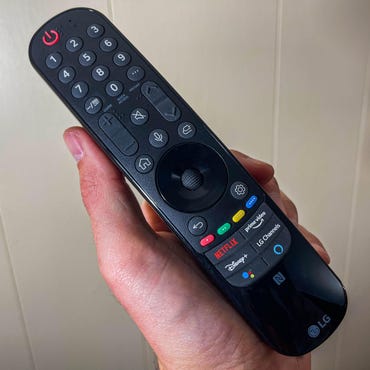
LG's redesigned remote still has lots of buttons and motion control.
Sarah Tew/CNETLG revamped the remote a bit. It kept my favorite features, namely the scroll wheel and motion-tracking, while slimming it down slightly. The biggest difference is the shortcut keys at the bottom: four for streaming services and two more for the built-in voice assistants, Google Assistant and Amazon Alexa. The former wasn't yet available on my G1 review sample, but LG says it will be soon.
The G1 is also equipped with a far-field mic (not available on the C1) so you can simply say the wake word to get the TV to respond, no remote required. It responded just like I'd expect from a smart speaker to my "Alexa" commands.
Based on my experience with the CX, both Google and Alexa can do all the usual assistant stuff, including control smart home devices, answer questions and respond via a voice coming out of the TV's speakers (yep, both voices). Basics like "What's the weather?" works as you'd expect, complete with onscreen feedback. The G1 also works with Apple's AirPlay 2 system, just like many other TVs, allowing my iPhone to share photos and video to the screen from the Photos app and mirror my Mac and phone screens.
LG's webOS menu system got a facelift for 2021 -- and I'm not a fan. Gone is the small, unobtrusive overlay at the bottom of the screen that lets you keep tabs on what you're watching. Instead there's a full-screen homepage, similar to Roku, Fire TV and Android TV. But it has fewer apps and more, well, junk. The top two-thirds of the screen are devoted to the weather, setup tips, a search window and a Trending Now section with a random collection of TV shows and movies. Below that is an app row and, further down, sections devoted to inputs and particular streaming apps. In general it feels like a hodgepodge with too much going on, and most systems are simpler and easier to grasp.
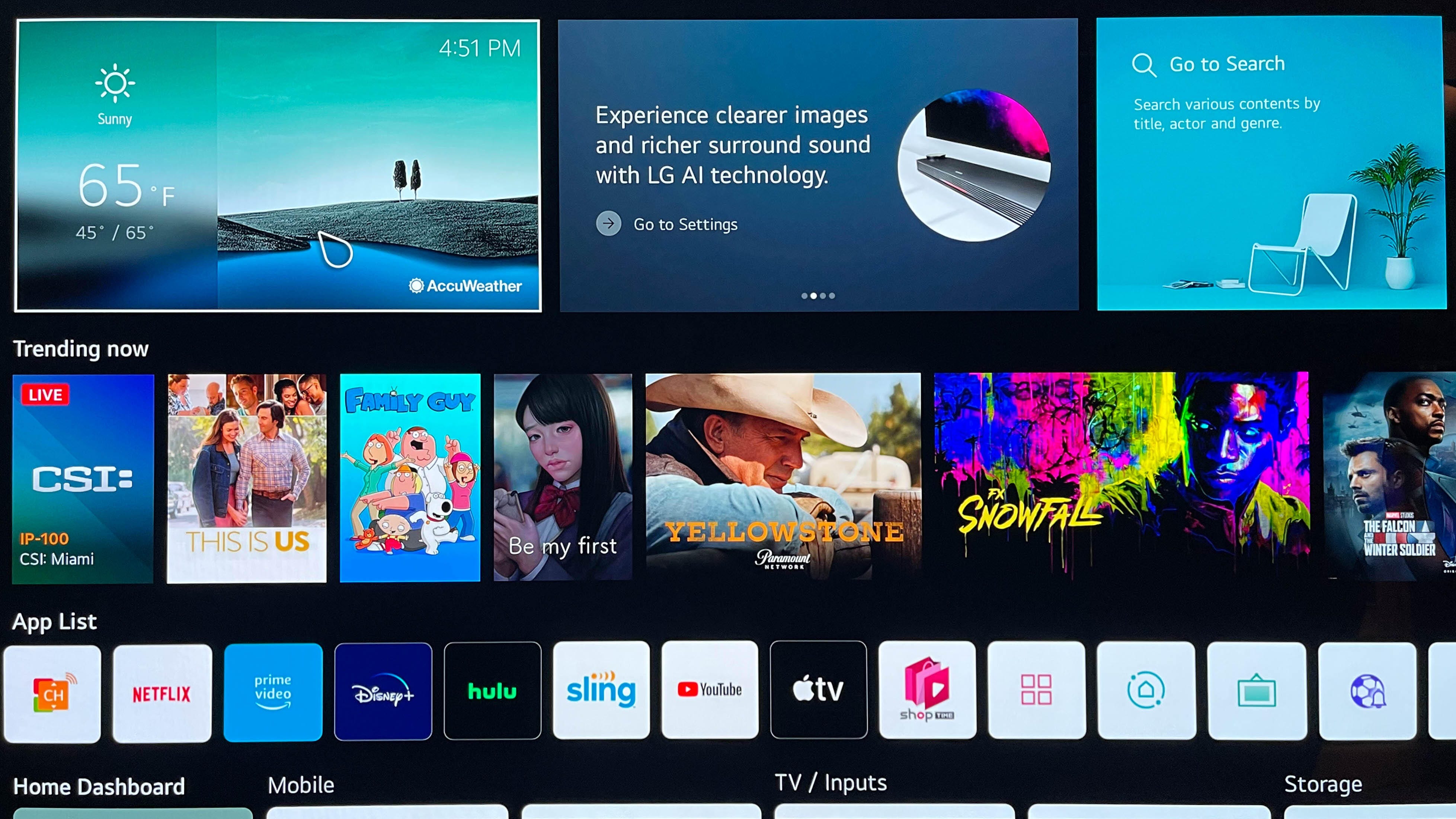
The new homepage takes up the entire screen.
Sarah Tew/CNETFeatures galore, state-of-the-art connectivity
LG says its Evo panel, available only on the G1 this year, uses a "new luminous element" for more precise lighting. The construction of the OLED pixel itself is different, with new materials for red and blue and a new green layer, all of which have narrower wavelengths compared to the pixels used on other OLED TVs.
Key TV features
| Display technology | OLED |
|---|---|
| LED backlight | N/A |
| Resolution | 4K |
| HDR compatible | HDR10 and Dolby Vision |
| Smart TV | Web OS |
| Remote | Motion |
Otherwise the G1 has the same image quality features as the C1, starting with the new Gen 4 a9 processing chip that adds scene detection and upgraded object enhancement over last year's version. Both the G1 and C1 also have a 120Hz refresh rate. The entry-level A1 OLEDs, meanwhile, have a more basic a7 processor and 60Hz refresh rate.
Just like last year, LG's OLED TVs' picture settings include a Filmmaker Mode. As promised, it turns off the soap opera effect for film-based content (yay) but so do many other modes in the G1. While plenty accurate, Filmmaker Mode is also relatively dim so I ended up using Cinema and ISF Bright for most critical viewing.
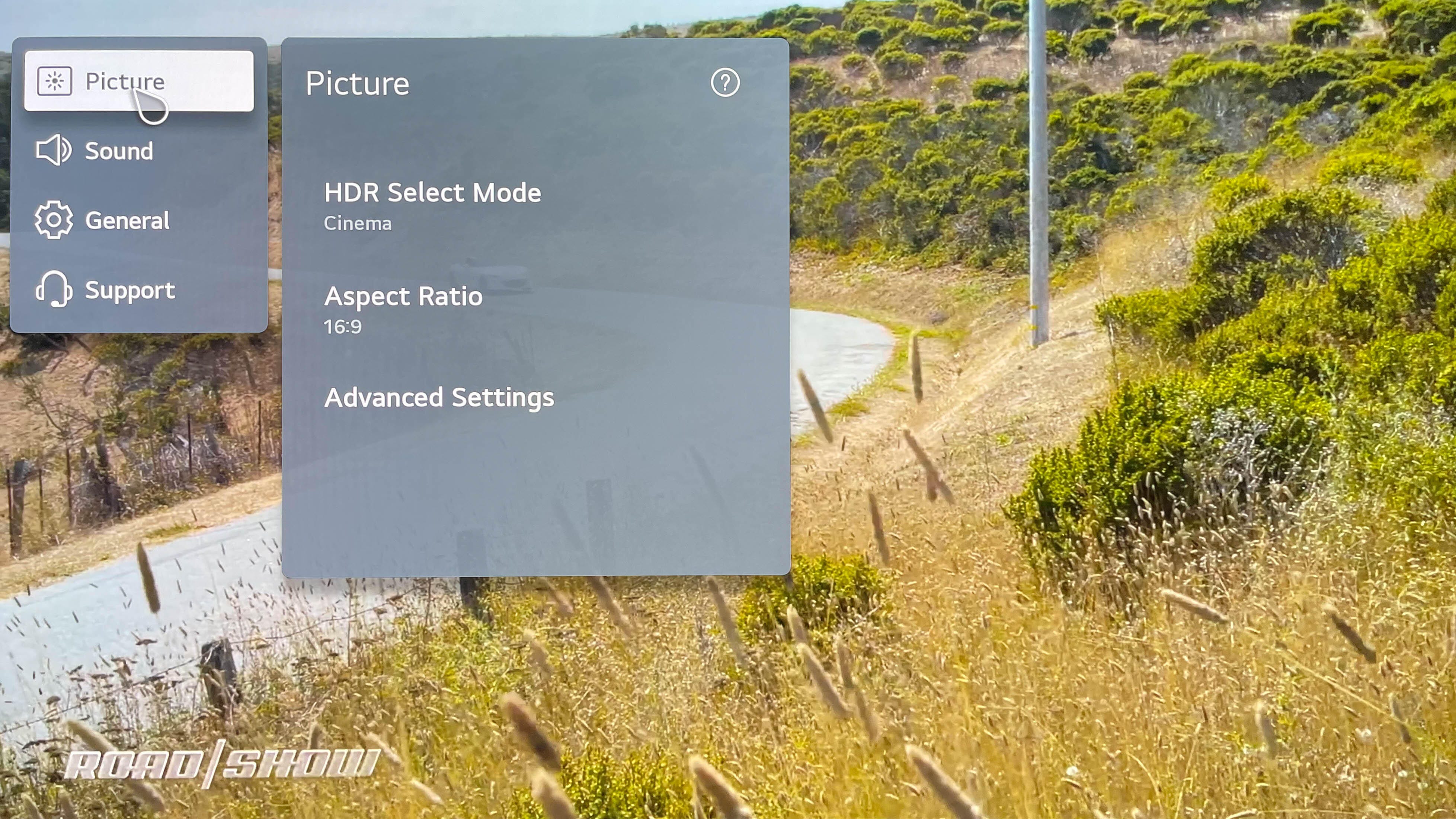
All of LG's recent OLED models (except the A1) include the latest version of the HDMI standard: 2.1. That means their HDMI ports can handle 4K at 120 frames per second and variable refresh rate (VRR, including NVIDIA G-sync and AMD FreeSync), as well as enhanced audio return channel (eARC) and automatic low latency mode (ALLM, or auto game mode). That means they can take advantage of the latest graphics features available on PlayStation 5 and Xbox Series X and S. New for 2021 is a Game Optimizer mode that puts all of the TVs' gaming-related settings in one place; see below for details.
The selection of connections is otherwise top-notch, though it no longer supports analog component video. There's also a dedicated headphone or analog audio output and another for IR blasters, which could ease some installations.
- Four HDMI inputs with HDMI 2.1, HDCP 2.2
- Three USB 2.0 ports
- Optical digital audio output
- Analog audio 3.5mm headphone output
- RF (antenna) input
- RS-232 port (minijack, for service only)
- IR blaster port (minijack)
- Ethernet (LAN) port
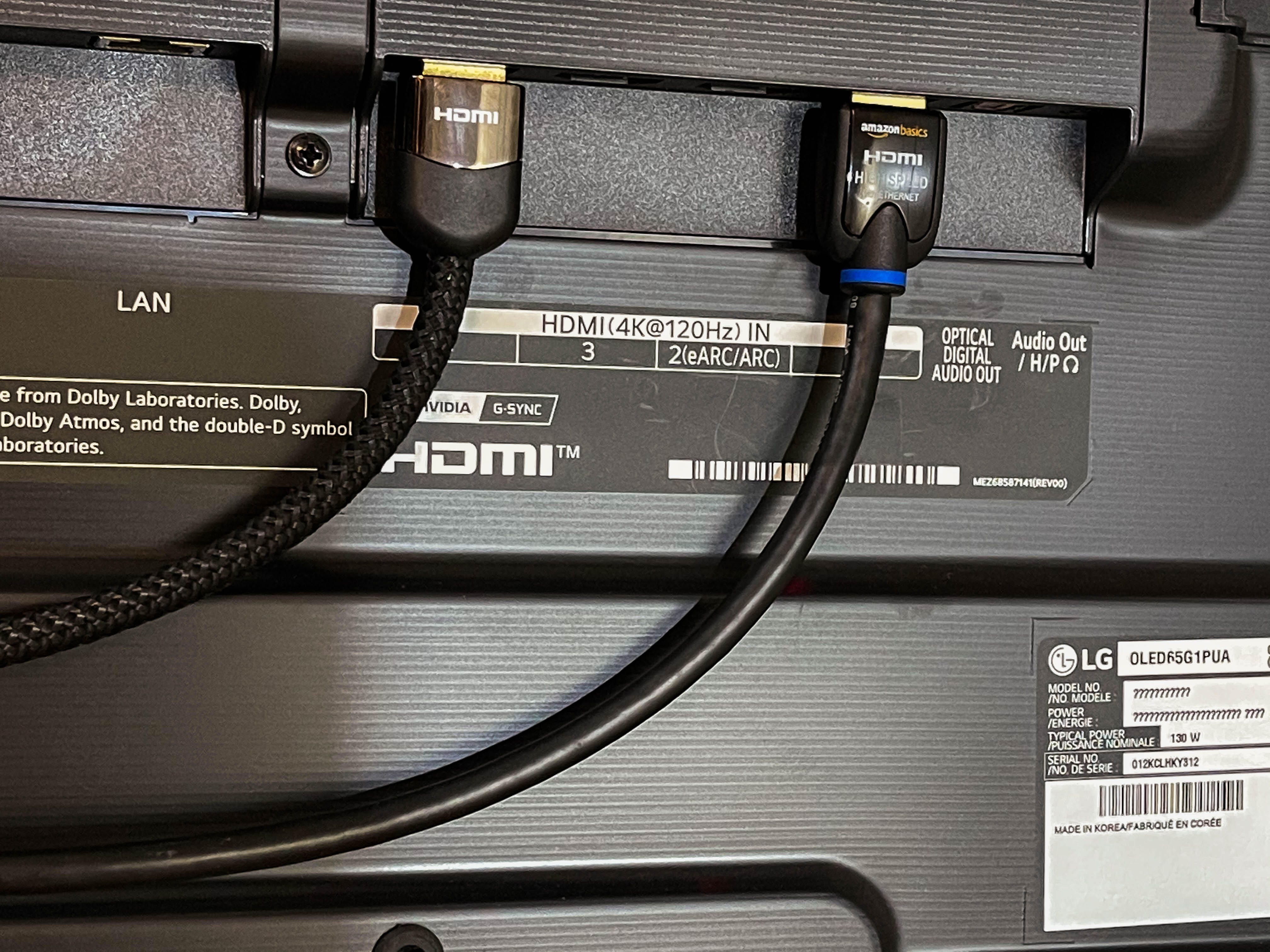
Picture quality comparisons
With its slightly better picture and a couple of other minor improvements the G1 beat the CX, my previous picture quality champ, in side-by-side comparisons. According to my measurements and eyeballs, however, the brightness difference was minor enough to be invisible at times, and just about every other aspect of picture quality was virtually identical. Both TVs looked a tad better than the less expensive Vizio OLED.
Dim lighting: The G1 performed like a champ with the lights down low -- and so did the other two OLED TVs in my comparison. I checked out The Hobbit, An Unexpected Journey on standard Blu-ray, and they all appeared more or less uniformly excellent: perfect black levels in the letterbox bars and deep shadows of Bilbo's living room during the dark Dwarven chant (36:58) and plenty of details in the shadows and clothing of Thorin and company. I couldn't see any real advantage of the G1 with this kind of theatrical situation in standard (non-HDR) material.
Bright lighting: For a TV billed by LG as an improvement in brightness, the G1's measurements didn't really stand out. Yes, it did measure brighter than last year's CX by 129 nits in the most accurate HDR modes, but that's not a huge leap and proved tough to discern in most program material. I was also surprised that the C9 I reviewed from 2019 was brighter at maximum light output and basically the same in its accurate mode. As usual, any high-end LCD is much brighter.
Light output in nits
| TV | Brightest (SDR) | Accurate color (SDR) | Brightest (HDR) | Accurate color (HDR) |
|---|---|---|---|---|
| TCL 65R635 | 1,114 | 792 | 1,292 | 1,102 |
| Sony XBR-65X900H | 841 | 673 | 989 | 795 |
| Vizio P65Q9-H1 | 768 | 629 | 1,305 | 1,084 |
| Samsung QN65Q80T | 664 | 503 | 1,243 | 672 |
| LG OLED65G1 | 377 | 334 | 769 | 763 |
| LG OLED65CX | 377 | 290 | 690 | 634 |
| LG OLED65C9 (2019) | 451 | 339 | 851 | 762 |
I asked LG's representatives whether my particular review sample's brightness was typical of other G1's and they said it was. As always, different sizes and samples can produce variations.
LG OLEDs of recent vintage have a setting called Peak Brightness that boosts the light output for SDR sources in Cinema and Expert modes. The idea is to increase contrast for brighter viewing environments while maintaining the superior color accuracy of those modes. As with most TVs, the brightest mode for HDR and SDR (Vivid on the G1) is horribly inaccurate. For the accurate color columns above on the G1, I used ISF Expert Bright (Peak Brightness: High) for SDR and Cinema mode for HDR -- I recommend G1 owners do the same to get good color in bright rooms.
All recent OLED sets are still plenty bright enough for just about any viewing environment. Yes, they do get quite a bit dimmer than LCDs when showing full-screen white -- a hockey game, for example -- but even in those situations they're hardly dim. The G1's screen preserved black levels and reduced reflections very well.
Color accuracy: LG claims better color with the new Evo panel but according to my measurements and eyeballs, it's tough to spot any difference. Color on the CX was excellent and the G1 was basically the same. An LG rep told me that the G1's white color could look more pure, like in a hockey match, but I didn't see or measure any differences in full-field white/gray (ones that weren't due to very small differences in grayscale after calibration, at least).
Watching The Hobbit was mostly the same story, although at times greens, like the grass and hillsides of the Shire (12:24), appeared a bit more greenish and less yellowish on the G1. It was a subtle difference at best, and again I didn't see or measure any difference in green test patterns, but it could be due to the new panel. Maybe.
Color on the G1 was nonetheless ext





























